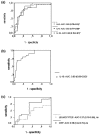Circulating immune parameters predicting the progression from hospital-acquired pneumonia to septic shock in surgical patients
- PMID: 16280065
- PMCID: PMC1414040
- DOI: 10.1186/cc3826
Circulating immune parameters predicting the progression from hospital-acquired pneumonia to septic shock in surgical patients
Abstract
Introduction: Hospital-acquired pneumonia after surgery is one of the major causes of septic shock. The excessive inflammatory response appears to be responsible for the increased susceptibility to infections and subsequent sepsis. The primary aim of this study was to investigate immune parameters at the onset of pneumonia, before the development of subsequent septic shock. The secondary aim was to investigate the usefulness of these immune parameters in predicting progression from hospital-acquired pneumonia to septic shock.
Methods: This prospective clinical study included 76 patients with the diagnosis of hospital-acquired pneumonia. Approval was obtained from the local institutional ethics committee and relatives of the patients gave informed consent. Of the 76 patients, 29 subsequently developed septic shock. All patients were included within 4 h of establishing the diagnosis of hospital-acquired pneumonia (first collection of blood samples and the analysis of immune mediators). In addition, we defined early (within 12 h of onset of septic shock) and late (within 72 to 96 h of onset) stages of septic shock for the collection of blood samples and the analysis of immune mediators. The immune parameters tumor necrosis factor-alpha, IL-1beta, IL-6, IL-8 and IL-10 as well as the endothelial leucocyte adhesion molecule were analyzed.
Results: In the pneumonia group with subsequent septic shock, levels of IL-1beta, IL-6, IL-8 and IL-10 were significantly increased before the onset of septic shock compared to patients without subsequent septic shock. This progression was best predicted by IL-1beta, IL-6, IL-8 and IL-10 (area under the curve > or = 0.8).
Conclusion: At the onset of hospital-acquired pneumonia, a significant relevant systemic cytokine mediated response had already been initiated. It might, therefore, be possible to identify patients at risk for septic shock with these predictive markers during early pneumonia. In addition, immune modulating therapy might be considered as adjuvant therapy.
Figures

Comment in
-
Can we predict septic shock in patients with hospital-acquired pneumonia?Crit Care. 2005;9(6):640-1. doi: 10.1186/cc3919. Epub 2005 Nov 11. Crit Care. 2005. PMID: 16356255 Free PMC article.
References
-
- American Thoracic Society Hospital-aquired pneumonia in adults: diagnosis, assessment of severity, initial antimicobial therapy, and preventive strategies. Am J Respir Crit Care Med. 1996;153:1711–1725. - PubMed
-
- Rodriguez JL, Gibbons JK, Bitzer LG, Dechert RE, Steinberg SM, Flint LM. Pneumonia: incidence, risk factors, and outcome in injured patients. J Trauma. 1991;31:907–914. - PubMed
-
- McEachern R, Campbell GD., Jr Hospital-acquired pneumonia: epidemiology, etiology, and treatment. Infect Dis Clin North Am. 1998;12:761–779. - PubMed
Publication types
MeSH terms
Substances
LinkOut - more resources
Full Text Sources
Medical

